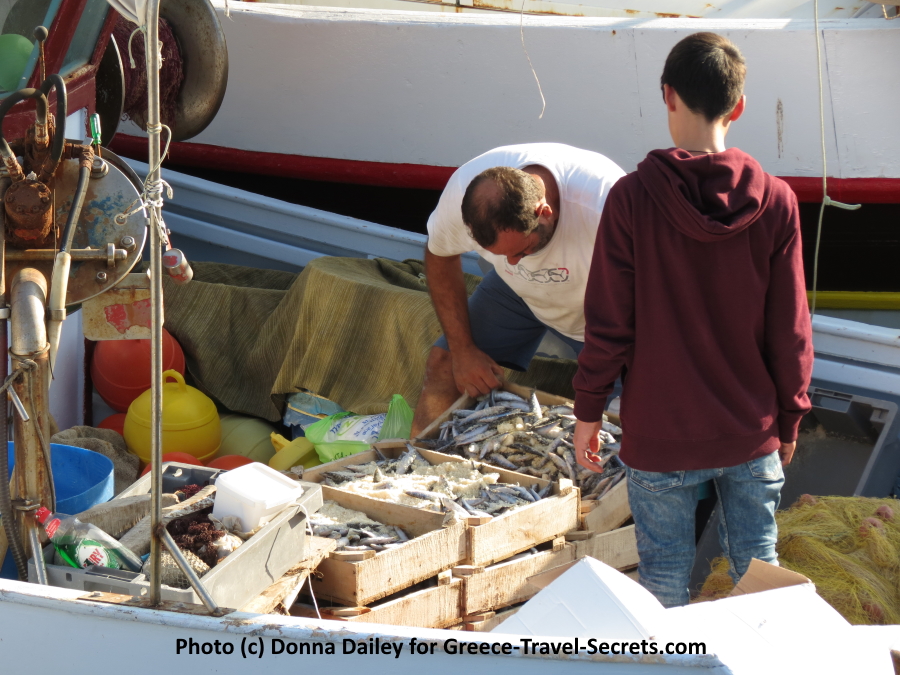Irakleio's Harbour and Venetian Fortress
Irakleio’s Venetian Harbour is one of its most attractive features, and a stroll around here with a visit to the Venetian Fortress that guards it is a relaxing treat.
From the Fortress you get an excellent view not only of the city but of the remains of the Venetian shipyards, or Arsenali, across the water.
Venetian Shipyards
Close up, the Arsenali is none-too-impressive, surrounded as it is now by the modern city, but the view from the Fortress shows something of their old scale and style. A look at the model in the Historical Museum in Irakleio also helps re-create a picture of what life must have been like under Venetian rule.
These 16th century shipyards would have resounded to the noise of large boats being built and repaired, where today it is the bobbing of the small boats belonging to Irakleio’s fishermen which sets the tone.
The Fortress
The Fortress which dominates the harbour entrance was built in the period 1523-40, though there have been several earlier forts on the site, one being destroyed in an earthquake in 1303. The Venetians rebuilt it and named it the Rocca al Mare, the Rock in the Sea, and the impressive name is appropriate for the impressive building you discover beyond the entrance gate.
Inside you step into a huge and dark vaulted room, with other rooms and passageways leading off it. Ahead and to the right, a long and steep slope leads to the upper levels, where visitors can climb the walls for the excellent views of the harbour and city beyond, or out to sea. The walls have some towers too which can be entered, for even greater height.
Turkish Seige
While here, mull over the most significant episode in the history of the Fortress. In 1647 the Venetian rulers of Irakleio and the rest of Crete retreated into the Fortress under siege from Turkish invaders. That siege was to last until 1669 and so became one of the longest in history. Eventually the Venetians had to succumb, but only after a long and bloody struggle during which it is said that 30,000 Venetians and 118,000 Turks lost their lives.
The Fortress has been extensively refurbished and some say it now looks more like a film set, but its scale remains remarkable. It now sometimes houses temporary exhibitions, and occasional plays and concerts on a stage set up in the upper level.
Top Tip
When an exhibition is on the opening hours sometimes change, so you may want to check in advance if planning a special visit.
The Winged Lion
The winged lion of St Mark the Evangelist was the emblem of the Venetian Republic. It was depicted in all areas under its dominion, carved in limestone or marble above gateways or on public buildings and fortifications. Some 80 reliefs have been recorded on Crete.
Hidden Gem
Look for the Lions of St Mark above the entrance gate and on the seaward wall.
Latest Posts
-
The Lesser-Known Traditions of Greek Easter
Step off the beaten path this spring and discover the enchanting — and often surprising — Easter traditions found across Greece. -
Easter in the Mystical Castle of Monemvasia
In the castle town of Monemvasia, with its dramatic medieval backdrop and sea views, Easter is a deeply spiritual and atmospheric experience. -
Sifnos: Greece’s Hidden Culinary Star on the Rise
Sifnos, a Cycladic island, is gaining fame for its rich culinary heritage, especially the beloved melopita honey-cheese tart. -
Easter in Leonidio: A Tapestry of Light, Culture and Cliffs
In Leonidio, Easter comes alive with handmade hot air balloons in the sky and lanterns made from bitter oranges in the streets. -
April 9 Strike in Greece to Impact Public Transport, Ferries and Air Travel
Transportation and travel across Greece will face disruptions on Wednesday, April 9, as public transport, ferry and aviation workers join a nationwide strike called by Greek labor unions. -
Ancient Theater of Lefkada Brought Fully to Light Following Systematic Excavation
The Greek Culture Ministry has announced that the first ancient theater ever identified in the Ionian Islands has recently been brought fully to light on Lefkada, revealing an impressive monument that… -
Seven Greek Traditions Recognized as Intangible Cultural Heritage
From traditional barrel-making to age-old folk dances, seven new entries on Greece’s National Inventory preserve the country’s living heritage for future generations. -
Greek Air Traffic Controllers to Hold 24-hour Strike, Disrupting Flights on April 9
The Hellenic Air Traffic Controllers Union have announced a 24-hour strike for Wednesday, April 9, in response to the protest called by the Civil Servants’ Confederation (ADEDY). The strike is being h… -
Ten Best Budget Hotels on Santorini
Greece Travel Secrets picks the ten best budget hotels on Santorini, some with caldera views, some near beaches and some close to the heart of Fira. -
No Ferries in Greece on April 9 as Seamen Join Nationwide Strike
The Pan-Hellenic Seamen’s Federation (PNO) has announced its participation in the 24-hour strike called by the General Confederation of Greek Labor (GSEE) on Wednesday, April 9. The strike, which will…














